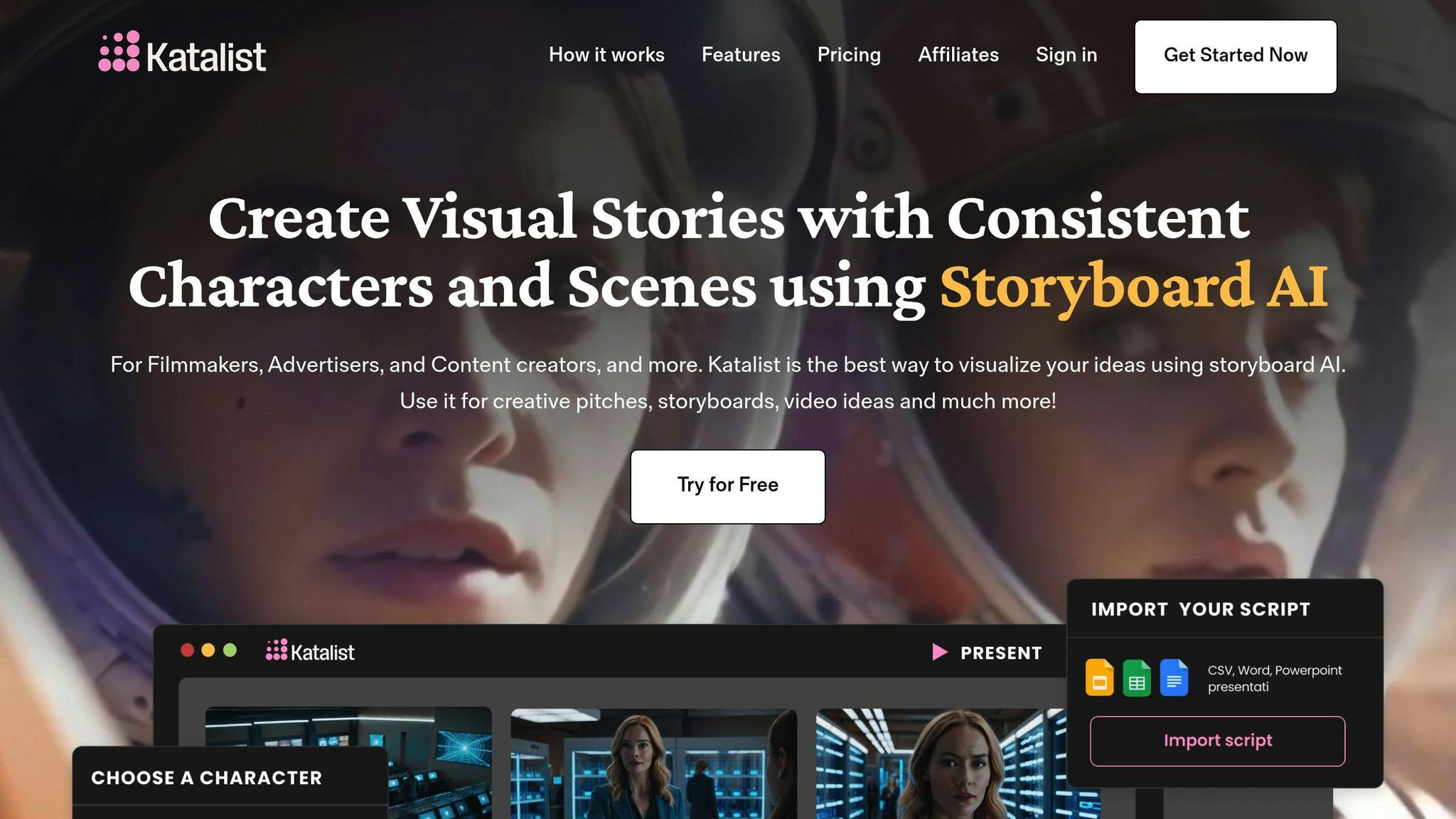
LongStories is constantly evolving as it finds its product-market fit. Features, pricing, and offerings are continuously being refined and updated. The information in this blog post reflects our understanding at the time of writing. Please always check LongStories.ai for the latest information about our products, features, and pricing, or contact us directly for the most current details.
AI Storyboarding vs. Traditional Methods
Quick Answer: AI storyboarding saves time and money by automating tasks, while manual methods offer full creative control for detailed, artistic projects. Your choice depends on your project’s needs - speed and efficiency (AI) or artistic depth (manual).
Key Differences:
- Time: AI tools work in minutes; manual takes weeks.
- Cost: AI is subscription-based and budget-friendly; manual involves higher artist fees.
- Skills: AI requires minimal expertise; manual needs artistic talent.
- Control: Manual allows full customization; AI relies on templates.
Quick Comparison Table:
| Aspect | Manual Storyboarding | AI Storyboarding |
|---|---|---|
| Time Efficiency | Slow and labor-intensive | Fast and automated |
| Cost | High upfront costs | Low subscription costs |
| Skills Needed | Artistic expertise | Minimal technical skills |
| Customization | Full creative control | Template-based options |
| Output Quality | High, nuanced | Consistent, less detailed |
Best Uses:
- Manual: Feature films, emotional stories, and unique visuals.
- AI: Marketing, eLearning, and social media projects with tight deadlines.
For the best results, combine both: Use AI for drafts and manual methods for refining key scenes.
AI Storyboard Tool - Katalist Review Workshop

Manual vs AI Storyboarding: Key Differences
Manual Storyboarding Process
With traditional storyboarding, artists create visuals frame by frame, either by hand or using digital tools. Each scene is carefully crafted, focusing on composition, angles, and flow. While this method offers complete artistic control, it requires a lot of time and effort to refine every detail. It's a process rooted in precision but can be quite demanding.
AI Storyboarding Tools and Features
AI-powered storyboarding tools have changed the game by automating many of the more tedious steps in pre-production. Platforms like LongStories.ai simplify the process by converting scripts into visuals quickly, using AI algorithms. Users can customize the output with templates and style options, making it accessible even for those without artistic skills. This automation removes many technical hurdles, enabling anyone to create polished storyboards.
Side-by-Side Comparison
| Aspect | Traditional Storyboarding | AI-Powered Storyboarding |
|---|---|---|
| Time Efficiency | Slow and labor-intensive | Quick and automated |
| Cost | High (artists, materials) | Lower (subscription-based) |
| Skills Needed | Requires artistic expertise | Minimal technical knowledge |
| Customization | Full manual adjustments | Template-driven customization |
| Output Quality | High, with creative control | Consistent but less nuanced |
The main difference between these methods lies in their approach to creating content. Manual storyboarding prioritizes creative control, while AI tools focus on speed and accessibility. Choosing the right method depends on what matters most for your project - control or efficiency.
"AI tools shift focus from technical execution to refining core narratives, fostering creativity".
In eLearning, AI storyboarding tools stand out for their ability to deliver personalized, consistent, and data-informed results. When exploring AI options, it's essential to factor in the total cost of ownership, including training, support, and customization needs. This ensures the chosen tool fits both current and future project goals.
sbb-itb-94859ad
Pros and Cons Analysis
Speed and Production Time
AI-powered tools can create storyboards in just minutes, a stark contrast to the weeks or even months required by traditional, manual methods. This speed is a game-changer for projects with tight deadlines, such as advertising campaigns or educational content that needs to be developed in parallel. While the time savings are undeniable, the financial impact of using AI tools is just as noteworthy.
Budget Considerations
Choosing between manual and AI-driven storyboarding has a big impact on costs. Traditional methods often come with hefty upfront expenses:
| Cost Factor | Traditional Method | AI Method |
|---|---|---|
| Upfront and Revision Costs | High (artist fees) | Low (subscription-based) |
| Scaling Costs | Linear increase with volume | Minimal incremental cost |
AI tools have reshaped this landscape by introducing subscription-based pricing, which lowers barriers for smaller teams and independent creators. This affordability has been particularly helpful for educational institutions and startups working within tight budgets.
Quality and Control
When it comes to storyboarding, quality isn't just about technical precision - it's about achieving creative goals. AI tools are great for maintaining consistency across large projects and enabling quick iterations. However, they may fall short in delivering the subtle, artistic interpretations that experienced storyboard artists bring to emotionally complex scenes.
"AI tools shift focus from technical execution to refining core narratives, fostering creativity while maintaining consistent quality across projects".
AI tools also use data analytics to refine storyboards based on audience engagement patterns, ensuring visuals resonate with viewers. This is especially useful in eLearning, where engagement is critical to success. By combining data-driven insights with fast iteration cycles, AI tools offer a unique way to balance quality and efficiency.
The trick is knowing when to use each method. For highly stylized or emotionally rich scenes, traditional methods may still be the best choice. On the other hand, AI tools shine in projects requiring quick turnarounds and consistent results across multiple episodes or lessons. Matching the method to your project's needs ensures both creative and logistical goals are met.
Best Uses and Applications
Manual Storyboarding Applications
Manual storyboarding works best for projects where artistic detail and creative control are non-negotiable. For example, feature films and animations from studios like Pixar and DreamWorks rely heavily on this method to capture emotional nuances and carefully craft complex scenes.
Independent films and experimental productions also benefit from manual storyboarding, as it allows for more interpretive and visually distinctive approaches.
While manual methods shine in artistry and precision, AI tools bring speed and efficiency to the table, as discussed next.
AI Storyboarding Applications
AI-powered tools have revolutionized industries that require fast and large-scale content creation. Tools like LongStories.ai are particularly effective in these areas:
| Industry | Key Advantages | Common Uses |
|---|---|---|
| Education | Quick creation of standardized lessons | Video lessons, interactive tutorials |
| Marketing | Rapid storyboard generation for testing | Social media content, product demos |
| Corporate Training | Scalable content production | Onboarding, compliance training |
Digital Marketing and Advertising: AI tools allow marketers to create multiple storyboard variations in minutes, making A/B testing and campaign launches much faster.
Educational Content: The eLearning industry has embraced AI for its ability to produce consistent storyboards across extensive course libraries. These tools save time while ensuring quality, especially when tailoring materials for different subjects.
Social Media Content: AI simplifies the creation of high-volume social media videos by transforming text-based ideas into visual content quickly and affordably.
Choosing between manual and AI methods depends on your project’s priorities - manual for creative depth, AI for speed and scalability.
Conclusion: Method Selection Guide
Main Points Summary
Choosing between manual and AI-driven storyboarding reflects a shift in how content is created. AI tools have made storyboarding faster and more accessible, while manual methods still excel in artistic expression and creative control.
Here's a quick comparison:
| Aspect | Manual Storyboarding | AI Storyboarding |
|---|---|---|
| Time Investment | Weeks to months | Minutes to hours |
| Cost Structure | High upfront costs | Subscription-based |
| Creative Control | Full artistic freedom | Template-driven, customizable |
Your choice will depend on the specific needs of your project.
Selection Guidelines
To decide which method suits your project best, consider these factors:
Project Timeline and Budget: AI tools are ideal for tight schedules and projects requiring multiple revisions. They also operate on subscription models, making them a cost-effective option for smaller teams or startups.
Quality Expectations: Manual storyboarding is better suited for projects that require a distinct artistic vision or emotional depth, where subtle details matter most.
Team Expertise: If your team lacks artistic skills but still needs high-quality storyboards, AI tools can bridge the gap. Using Natural Language Processing (NLP), these tools can turn text descriptions into visual stories.
For the best results, consider combining both methods. Use AI tools for quick drafts and initial concepts, then refine key scenes manually to ensure they meet your creative standards. This approach balances efficiency with attention to detail.
